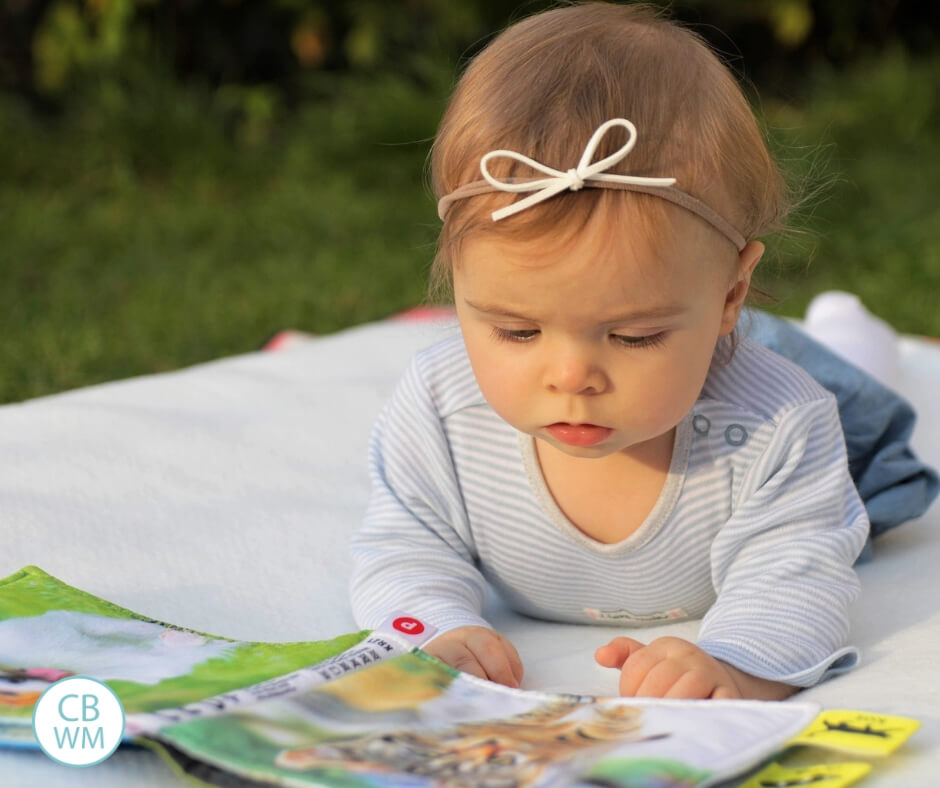Blanket time is a helpful tool to help you teach your child to respect boundaries. It can be a nice quiet time that is structured each day. Find out what is blanket time, the benefits of blanket time, how to implement blanket time, and what to do if baby resists blanket time.

As you read through the various -wise books, it is very easy to miss the information on blanket time. I missed it the first couple of times I read through Toddlerwise, and then I had a hard time finding information on it when I knew about it and tried to find it.
Blanket Time Defined
Blanket time is a Babywise series principle to help children learn boundaries. They learn to sit still and play independently.
In On Becoming Toddlerwise, blanket time is mentioned on pages 45 and 48. Page 45 says for toddlers between ages 14-18 months to do time on a blanket 2-3 times a week for 10-15 minutes at a time.
The purpose of this is to teach parameter skills. Page 48 says for toddlers between ages 14-20 months old, starting with 5 minutes at a time each day. You then work up to 30 minutes or longer.
Blanket time is similar to independent play time, but your child isn’t alone; you are right there. You can interact with your child if you like. You can give instruction to your child. You could have all of your children do blanket time together in the same room. Your child is doing it all on the blanket–an obvious boundary.
>>>Read: Independent Playtime Overview
You can have blanket time for babies and blanket time for toddlers.
You want to make sure your child is on a blanket or mat of some sort. You do not want your child in a playpen with a literal boundary. You want the boundary to be seen but not literally keeping baby back. This is not playpen time nor independent playtime. The child is in the room with other people.

Blanket Time Benefits
There are many benefits to Blanket Training, including:
- Having a tool to keep a child in place
- Teaching a child self-control
- Teaching children to learn to recognize boundaries
- Testing obedience. Blanket time is great obedience training
Your child learns a lot of self-control as she sits and plays without physical boundaries. The only thing keeping her there is her willingness to listen and obey.
Think of your little one sitting on a blanket playing while you finish up dinner. Picture how much easier church would be with blanket time as an available tool. Imagine visiting great-grandma and being able to put baby down and know she won’t zip off and break some family heirloom.
Think of going outside with your child and having a spot you know he would stay. Soccer games can be so much easier when your child is staying on a blanket through the game. How much easier would appointments be with this tool at hand? I know this is a tool very loved by homeschooling families. There are many benefits and uses in a homeschooling environment.
Real Mom Reviews
One mom said: “I think it’s an awesome tool and teaches skills that they don’t learn with roomtime only (staying within boundaries that are not as defined as walls). My little girl is so busy and runs around the house constantly, from one activity to the next. Surprisingly, she LOVES blanket time and I think it is because she can actually focus on a couple toys. One tip I would have is to use a kitchen timer – both for her sake and mine (so I don’t forget to get her off in good time). Also, use special toys that aren’t available at other times of the day. “
Another mom said: “If you don’t do blanket time, you should. Our kids are older now, but we still talk about how great it was. One time we were in a business and had our young son with us. He was fascinated by everything to get into. I pointed out the edges of a rug to him and told him to stay on the rug. He did! Everyone else was amazed.”
Another mom shared: “I agree its very helpful with recognizing boundaries! My current 2yo does it while we the rest of us are prepping breakfast and doing chores. Her mat is on the kitchen floor. I have one activity that we use for awhile until she tires of it (a week or 2). Currently she has her dollhouse out.”
>>>Read: A Parent’s Guide to Structured Playtime

Blanket Time in Action
You can start blanket time at any age, from infant on through preschooler. You can stop it before your baby can move and simply establish an expectation that the child stays on the blanket. The age you start it would really depend on you and your child.
You can put a completely immobile 8 month old on a blanket to play, but if he can’t move anywhere it isn’t true blanket time. That doesn’t mean you can’t start doing it–it can be useful to teach the habit before he has the option of moving, but he isn’t exercising any sort of personal restraint by staying on the blanket when he couldn’t move off of it in the first place.
You can do blanket time from a few months old on up to a 3 year old. You can really use the concept at any age you need it. There might be times you find you use the concept with your older children.
Start with 3-5 minutes at a time and work up from there. Show your child the border of the blanket and tell him to stay on the blanket. If (or probably when) your little one gets off the blanket, put your child back on the blanket and repeat to your child to stay on the blanket.
Use a timer to help track the time. Then the timer decides when blanket time is over and not your child’s whining.
>>>Read: 10 Uses for the Timer that Will Make Parenting Easier
Have a fun toy or activity for your child to do on the blanket. Do not load the blanket with toys. That will overwhelm your child. You can fun activities for your child on the blanket. You could add a book or two, also. Make sure the toys or books used for blanket time are used only for blanket time so they are novel. Rotate toys every so often.
When time is up, praise your child for doing blanket time. Praise for staying on the blanket. Be really happy and positive about it. Act like your child loved it even if your child was protesting.
Blanket Time FAQs
You probably have many questions about blanket time. Here are some answers to common questions with Blanket Time.
What Size of Blanket Should I Use?
You will want to start with a small blanket initially. It needs to be large enough that it can fit your child and some toys. You do not want it so large that your child basically has no boundaries.
You also do not want your child to be tempted to get up and move around (if able). This will introduce too much freedom and too much temptation to move off of the blanket.
The blanket is the physical parameter, so keep the size appropriate for your goals for the activity.
What Toys Should I Use?
Choose toys that your child can play with independently. You do not want a toy that your child will need your help with throughout the playtime. If mommy is stepping in frequently, it makes it so it is not an independent playtime.
You want toys your child is interested in and can have fun with. You want the toys to be fresh. Blanket time toys will ideally be toys only played with at blanket time. Remember, you can rotate toys to keep them fresh.
What Time of Day is Best for Blanket Time?
Whenever you are first introducing something into your child’s life that requires self-control, you want to be very wise in the time of day you do it.
Humans at every age are grumpy and less willing to work when they are tired or hungry.
Make sure your baby is well-rested and fed. You know your child and know when this is, but for most babies and toddlers, this will be in the morning after breakfast. Do not do it too close to the start of nap times or bedtime.
You also want to make sure that it is a time of day that works for you. You need to be close by while your little one does blanket time. Good mom activities during this time include going through your emails, reading a book, folding some laundry, etc.
Have something to do without being distracted and unable to respond to micro-rebellion right away.
It is best if initially, you are basically sitting in one place while you expect your little one to stay in one place. If you are walking in and out of the room, your kiddo will probably want to try to follow.
You want to be wise in how you set this up so you can avoid tantrums and power struggles.
How Long Should Blanket Time Be?
You will start with just a few minutes. It could be as short as two minutes. You eventually want to work up to about 30 minutes.
What Do I Do If My Child Gets Off the Blanket?
This will probably happen. It will probably happen initially as you start blanket time if your child is mobile. It will probably also happen as your child gets older and is in a boundary-testing age.
When your child leaves the blanket, you put your child back. This is why you need to stay close and why you need to be doing something that can be interrupted immediately.
- Put your child on the blanket
- Verbally tell your child to stay on the blanket
- Repeat as needed
Even if your child just puts one hand or foot off the blanket, fix it. That is your child testing the boundary. That test will grow if you ignore it.
Remember to use a timer for blanket time. The timer will tell your child when this will end. This teaches your child the timer, not the tears, ends blanket time.
Keep the time short so the blanket doesn’t feel like a punishment.
Expect that you will have good days and bad days. There might be the random day your child just isn’t feeling blanket time. If that seems to be the case, you can always alter the time left on the timer and shorten it.
How Often Should I Do Blanket Time?
Consistency is always key. The more consistent you are with this, the more your child will like it. A predictable routine is always preferable.
Try to make it a part of everyday. Go for at least 2-3 times a week as discussed in the books, but 4-5 times (or 7!) a week will give you more consistency.
Once a day should work, but as you are training, you might do 2 minutes 2-3 times a day.
Where Should I Do Blanket Time?
Do it wherever it makes sense for you. This could be your living room, the kitchen, your bedroom, the toy room…whatever makes sense is a great spot.
You will want to be able to use this outside the home eventually, so it is a great idea to move around the house so your baby gest used to doing blanket time wherever she is.
Conclusion
Ultimately, here is my take on blanket time. Take blanket time and make it what you see your toddler in need of. Does your toddler need help learning boundaries? Does he lack some focusing skills? Do you have a need for blanket time in situations such as church? Use blanket time as needed in your home.
I like the use of blanket time as a time to teach parameter skills. I consider it a structured playtime situation. Again, use blanket time as you see fit for your child and your family’s situation.
This post originally appeared on this blog in April 2009


